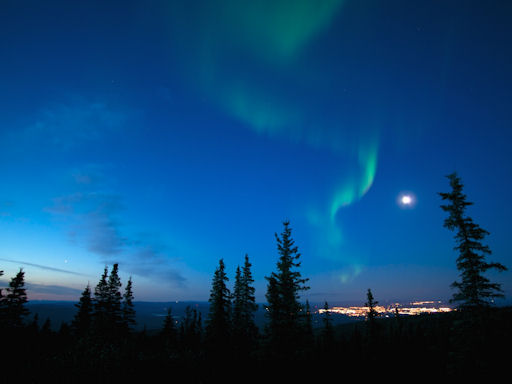'METEOR SMOKE' LINKED TO NOCTILUCENT CLOUDS: A key ingredient of Earth's strangest clouds does not come from Earth. New data from NASA's AIM spacecraft shows that "meteor smoke" is essential to the formation of noctilucent clouds. [full story] [video]
FIRST AURORAS OF THE SEASON: After a long summer of midnight suns and starless nights, the Arctic Circle is glowing with its first auroras of the new season. Todd Salat photographed the kick-off in Fairbanks, Alaska, on August 6th:
"From 1 am to 1:30 am local time I took these photos of the northern lights dancing above the Fairbanks city lights," says Salat. "Although the nights still do not get completely dark in the far northern latitudes, the deep blue twilight skies proved dark enough to make the auroras stand out. And at a balmy 55° F, it was quite a treat to be watching the lights in t-shirt weather."
The second auroras of the season could appear tonight. NOAA forecasters estimate a 30% chance of polar geomagnetic storms in response to the expected glancng blow from an incoming CME. Aurora alerts: text, phone.

![]()
Solar wind
speed: 394.3 km/sec
density: 5.5 protons/cm3
explanation | more data
Updated: Today at 1446 UT
![]()
X-ray Solar Flares
6-hr max: C4 1132 UT Aug08
24-hr: C4 1132 UT Aug08
explanation | more data
Updated: Today at: 1400 UT
![]()
![]()
![]()
Daily Sun: 08 Aug 12
![]()
![]()
Sunspot 1542 is cracklng with C-class flares. Credit: SDO/HMI
![]()
![]()
![]()
Sunspot number: 96
What is the sunspot number?
Updated 08 Aug 2012
Spotless Days
Current Stretch: 0 days
2012 total: 0 days (0%)
2011 total: 2 days (<1%)
2010 total: 51 days (14%)
2009 total: 260 days (71%)
Since 2004: 821 days
Typical Solar Min: 486 days
Updated 08 Aug 2012
The Radio Sun
10.7 cm flux: 129 sfu
explanation | more data
Updated 08 Aug 2012
![]()
![]()
![]()
Current Auroral Oval:
![]()
Switch to: Europe, USA, New Zealand, Antarctica
Credit: NOAA/POES
![]()
![]()
![]()
Planetary K-index
Now: Kp= 1 quiet
24-hr max: Kp= 4 unsettled
explanation | more data
![]()
Interplanetary Mag. Field
Btotal: 3.1 nT
Bz: 2.8 nT north
explanation | more data
Updated: Today at 1446 UT
![]()
![]()
![]()
Coronal Holes: 08 Aug 12
![]()
There are no large coronal holes on the Earthside of the sun. Credit: SDO/AIA.






Comments
More Solar Manifesting
X-flare for the people.